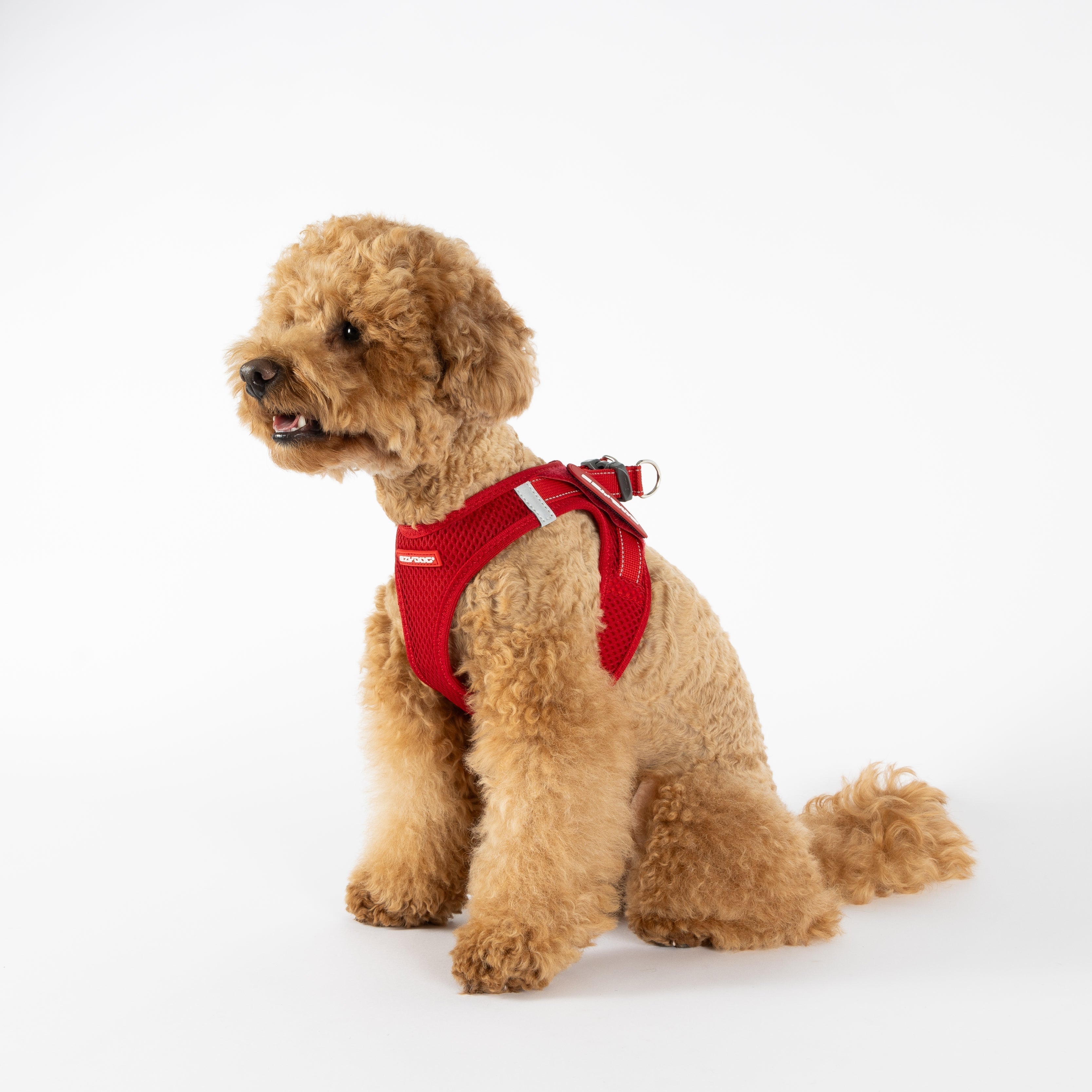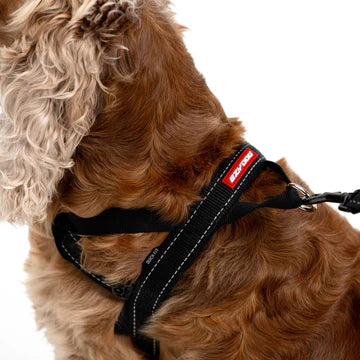
Types of Dog Harnesses: Which Style Is Right for Your Pet?
Finding the right dog harness is key to ensuring your pup is comfortable, safe, and ready for every adventure. With so many types of dog harnesses on the market, it’s easy to feel overwhelmed.
But don’t worry! Whether you’ve got a speedster, a snuggler, or a curious explorer, there’s a harness out there that’s just right for your four-legged companion. Let’s dive into the different types of dog harnesses and help you find the perfect fit for your pet.
Types of Dog Harnesses: An Overview
First things first, let’s take a quick look at the different types of harnesses for dogs. You’ve got your standard back-clip harnesses, front-clip harnesses, step-in harnesses, no-pull harnesses, safety harnesses, and even tactical or service harnesses for those hard-working pups. Each type has its own unique features and benefits, so let’s break them down to help you choose the best type of dog harness for your canine companion.
Standard Back-Clip Harness
What is it?
The back-clip harness is your everyday, go-to harness with a leash attachment point on the back. It’s like your dog’s comfy t-shirt—easy to put on, comfortable to wear, and great for everyday use.
Best For:
Calm dogs who don’t pull much on the leash, small to medium-sized dogs, or pups just starting with harness training. This style is also ideal for dogs with sensitive throats, such as Chihuahuas or Yorkies, who might find pressure from a dog collar uncomfortable or even harmful.
Product Suggestion:
The Quick Fit Dog Harness from EzyDog is an excellent option if you’re after a standard back-clip harness. It's designed for quick and easy fitting with just one click, making it ideal for everyday walks. With soft-touch webbing and an adjustable chest strap, the Quick Fit Harness offers a snug and comfortable fit for your dog, ensuring ease and control without putting pressure on their neck.
Pros and Cons:
Pros: Comfortable, simple to use, and provides easy control without putting pressure on the neck. It’s a popular choice among pet parents because it’s widely available and comes in various materials and designs.
Cons: Not ideal for strong pullers, as it can encourage dogs to pull even more. Dogs that pull excessively may experience discomfort or strain on their backs or shoulders with this type of harness.
Front-Clip Harness (Including Dual-Clip Options)
What is it?
A front-clip harness has a leash attachment point on the front of the dog’s chest, and many also come with a back-clip for added versatility. The front clip provides more control and discourages pulling, making it great for training. The dual-clip feature allows dog owners to switch between a front or back leash attachment, depending on their dog's behaviour or the type of walk they are planning.
Best For:
Dogs that tend to pull, training purposes, or owners who want flexibility in their control methods. This harness is ideal for large or active dogs, as well as those that need a little more guidance during walks.
Product Suggestion:
Consider the Express Harness, which offers both a front and back clip when paired with the UpFront D-Ring Attachment. This setup allows for dual-clip functionality, giving you full control over your dog’s pulling behaviour. The Express Harness is designed for comfort with moulded EVA foam padding and an ergonomic fit, making it perfect for everyday use or long adventures. Adding the UpFront D-Ring Attachment converts this back-clip harness into a dual-clip system, offering extra control when needed.
Pros and Cons:
Pros: Offers improved control, discourages pulling, and provides versatile handling options. By using the dual-clip setup, you can manage your dog's movements more effectively, especially during training sessions or in busy environments.
Cons: Needs correct fitting for effectiveness, and some dogs may take time to adjust to the front attachment. The additional D-Ring Attachment adds flexibility but may require extra care in ensuring both clips are securely attached for maximum benefit.
Step-In Harness
What is it?
The step-in harness is exactly what it sounds like: your dog steps into it, and you fasten it over their back. This style is great for dogs who dislike having a harness slipped over their heads. The step-in design makes it easy and quick to put on, which can be a blessing if you have a wiggly pup who gets excited about going out.
Best For:
Nervous dogs, dogs with anxiety, or those that get a bit fussy when putting on a harness. Step-in harnesses are especially useful for older dogs or dogs with mobility issues, as they don’t require as much bending or manoeuvring to secure.
Product Suggestion:
Try the Chest Plate Harness (With its ergonomic, step-in design, it contours to your dog’s shape, providing a comfortable and secure fit. Ideal for dogs that need a little extra encouragement to wear their gear, this harness minimises pressure on your pup’s chest. The Chest Plate Harness is also built to last, with durable materials that stand up to daily use, whether you're heading to the park or on an adventure.
Pros and Cons:
Pros: Easy to put on, comfortable for anxious dogs, and provides secure control. The step-in style is also less likely to tangle or twist during use, making it ideal for quick outings or busy mornings.
Cons: Can be less secure if not fitted properly, especially for dogs that are skilled escape artists. It’s crucial to ensure that all straps are snug and adjusted correctly to prevent slipping.
No-Pull Harness
What is it?
The no-pull harness is specifically designed to prevent pulling. It typically has features like a front clip and an even pressure distribution system to reduce your dog’s urge to pull. This harness type is often used for dogs that are still learning proper leash manners or those with a strong prey drive who may bolt unexpectedly.
Best For:
Dogs that pull hard, need training, or require extra control during walks. This style is particularly useful for energetic breeds like Huskies or Terriers, who might see every walk as an opportunity for a sprint.
Product Suggestion:
The Crosscheck Harness from EzyDog is a top choice. Its innovative design discourages pulling, distributes pressure evenly across the dog’s body, and includes that handy side attachment point for greater flexibility. It’s a fantastic training tool that keeps walks pleasant and stress-free. Pair it with reward-based training techniques, and you’ll be on your way to peaceful, enjoyable strolls in no time.
Pros and Cons:
Pros: Reduces pulling, prevents choking, and makes walks easier on your arms and shoulders. This harness is ideal for dogs prone to lunging or darting after distractions like birds or other dogs.
Cons: May cause discomfort if not properly adjusted. It’s essential to ensure a snug fit to prevent any rubbing or chafing, particularly during longer walks.
Safety Harness
What is it?
Safety harnesses are designed specifically for car travel, ensuring your dog stays safe and secure while you’re on the road. They typically attach to a seatbelt for added safety, minimising the risk of injury during sudden stops or accidents.
Best For:
Dogs that frequently travel in cars, or pet owners who prioritise safety during travel. These harnesses are perfect for road trips, daily commutes, or even short trips to the vet, offering peace of mind on every journey.
Product Suggestion:
For those road trips, the Drive Car Harness from EzyDog is the way to go. It’s crash-tested, easy to fit, and attaches directly to your car’s seatbelt for maximum safety. Keep your dog secure and comfortable on every journey, from quick trips to the vet to longer adventures. Plus, its streamlined design ensures that your dog won’t feel restricted or uncomfortable, making it a must-have for any road trip enthusiast.
Pros and Cons:
Pros: Provides extra safety for car travel, reduces distractions, and protects your dog in case of an accident. The harness is also designed to be easy to put on and take off, which is a big plus for busy pet owners.
Cons: Limited use outside of the car. While great for travel, this harness may not be the best choice for regular walks or other outdoor activities.
Tactical or Service Harness
What is it?
These harnesses are heavy-duty and built for service dogs or working dogs. They often have multiple attachment points, handles, and extra features like pouches or storage options. Tactical harnesses are designed to be highly durable, withstand rough conditions, and provide maximum functionality.
Best For:
Service dogs, working dogs, or dogs in training. These harnesses are also great for hiking and outdoor adventures, where additional features like storage pouches can come in handy.
Product Suggestion:
The Convert Harness is a perfect choice for tactical use. It’s durable, versatile, and can be enhanced with Convert Saddle Bags, making it ideal for carrying treats or supplies. Perfect for longer adventures or tasks that require your dog to carry their own gear. The harness also includes easy-to-use side-release buckles and a secure fit, ensuring your dog stays comfortable and safe while working or exploring.
Pros and Cons:
Pros: Highly durable, customisable, and ideal for working dogs or adventurous pets. The ability to add saddle bags for extra storage is a big plus for owners who take their dogs on longer hikes or missions.
Cons: Can be heavier and more cumbersome for casual walks. This harness is designed for serious use, so it might be overkill for a simple stroll around the block.
Factors to Consider When Choosing a Dog Harness
Choosing the right harness isn’t just about style; it’s about finding what works best for your dog’s size, breed, behaviour, and specific needs. Consider whether your dog tends to pull, if they’re anxious about things going over their head, or if they frequently travel in cars. It's also important to think about your dog's age and health—older dogs or those with medical conditions may need a harness that is easy to put on and take off or one that provides additional support.
Remember, the best type of dog harness will depend on your dog's unique characteristics and your daily activities together. Always measure your dog properly before purchasing a harness to ensure a good fit, and consult with your vet or a professional dog trainer if you’re unsure which type is best.
Conclusion
Whether you have a gentle walker or a dog that thinks they’re the next sled race champion, there’s a harness that’s perfect for your pup. By understanding the different types of harnesses available, you can make an informed decision that ensures comfort, safety, and enjoyment for both you and your dog. Don’t be afraid to try different types until you find the one that fits both your dog's needs and your lifestyle best.
Explore Our Dog Harness Collection
Ready to find the perfect harness for your dog? Explore EzyDog’s range of harnesses and discover the best option for your adventures together!
Reviewed by Experts
This post has been quality-checked by SEO Expert Niraj Raut to ensure it’s clear, helpful, and accurate, and fact-checked by Ken, a dedicated dog expert and enthusiast, to guarantee reliable information for dog owners.





Leave a comment
This site is protected by hCaptcha and the hCaptcha Privacy Policy and Terms of Service apply.